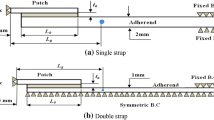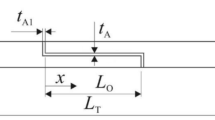Abstract
This study aims to predict the failure loads of adhesive double-strap joints (DSJs) with the help of validated finite element (FE) analyses performed in a commercial FE package (ABAQUS/Standard). The damage initiation and propagation in the adhesive was evaluated by a cohesive zone model. The effects of the patch part (i.e. material, length and thickness of the patch) on the failure load of the DSJs joints are investigated. In addition, a stress analysis of the adherends and patch part is performed to provide insights into the stress distribution in the materials, thereby avoiding potential premature or unsuitable failure in the different parts of the joints. It is revealed that the dimensions of the patch can have measurable influences on the failure load and the stress distribution in different parts of the joint which may threaten the suitable performance of the joints. Moreover, the results obtained from the joints with both aluminium and composite straps are almost the same, although considering the weight added to the system, the latter outweighs the other.














Similar content being viewed by others
References
Adams R, Peppiatt NA (1974) Stress analysis of adhesive-bonded lap joints. J Strain Anal 9:185–196
da Silva LFM, Ochsner A, Adams RD (2018) Handbook of adhesion technology, 2nd edn. Springer, Heidelberg
Banea MD, da Silva LFM (2009) Adhesively bonded joints in composite materials: an overview. Proc Inst Mech Eng Part L J Mater Des Appl 223(1):1–18
Akpinar S (2013a) Effects of different curvature patches on the strength of double-strap adhesive joints. J Adhes 89(12):937–947
Akpinar S (2013b) The effect of composite patches on the failure of adhesively-bonded joints under bending moment. Appl Compos Mater 20(6):1289–1304
Budhe S, Banea MD, de Barros S (2018) Bonded repair of composite structures in aerospace application: a review on environmental issues. Appl Adhes Sci 6(1):3
Marques EAS, da Silva LFM (2008) Joint strength optimization of adhesively bonded patches. J Adhes 84(11):915–934
Pinto AMG et al (2012) Effect of plug-filling, testing velocity and temperature on the tensile strength of strap repairs on aluminium structures. J Adhes Sci Technol 26(10–11):1481–1496
Pinto AMG et al (2014) Strap repairs using embedded patches: numerical analysis and experimental results. J Adhes Sci Technol 28(14–15):1530–1544
Çitil Ş et al (2011) Determination of mechanical properties of double-strap adhesive joints with an embedded patch. J Adhes Sci Technol 25(18):2555–2567
Çitil Ş, Ayaz Y, Temiz Ş (2017) Stress analysis of adhesively bonded double strap joints with or without intermediate part subjected to tensile loading. J Adhes 93(5):343–356
Temiz Ş (2006) Application of bi-adhesive in double-strap joints subjected to bending moment. J Adhes Sci Technol 20(14):1547–1560
Moreira RDF et al (2017) Numerical and experimental analyses of composite bonded double-strap repairs under high-cycle fatigue. J Adhes 93(12):980–992
Akpinar S (2013c) Effects of laminate carbon/epoxy composite patches on the strength of double-strap adhesive joints: experimental and numerical analysis. Mater Des 51:501–512
Razavi SMJ et al (2018) A strain-based criterion for failure load prediction of steel/CFRP double strap joints. Compos Struct 206:116–123
Al-Zubaidy H, Al-Mahaidi R, Zhao X-L (2013) Finite element modelling of CFRP/steel double strap joints subjected to dynamic tensile loadings. Compos Struct 99:48–61
Bayramoglu S, Demir K, Akpinar S (2020) Investigation of internal step and metal part reinforcement on joint strength in the adhesively bonded joint: experimental and numerical analysis. Theor Appl Fract Mech 108:102613
Nguyen T-C et al (2011) Mechanical characterization of steel/CFRP double strap joints at elevated temperatures. Compos Struct 93(6):1604–1612
Budhe S et al (2015) Effect of surface roughness using different adherend materials on the adhesive bond strength. Appl Adhes Sci 3(1):20
Semerdzhiev SG (1970) Metal-to-metal adhesive bonding. Business Books, London
Kozma L, Olefjord I (1987) Basic processes of surface preparation and bond formation of adhesively joined aluminium. Mater Sci Technol 3(10):860–874
Prakash R, Srivastava VK, Gupta GSR (1987) Behavior of adhesive joints in corrosive environment. Exp Mech 27(4):346–351
ABAQUS HTML Documentation (2014) Dassault systems
Jing J et al (2009) Simulation of dynamic fracture along solder–pad interfaces using a cohesive zone model. Eng Fail Anal 16(5):1579–1586
Campilho RDSG et al (2011) Strength improvement of adhesively-bonded joints using a reverse-bent geometry. J Adhes Sci Technol 25(18):2351–2368
Marami G et al (2016) Improving the mechanical behavior of the adhesively bonded joints using RGO additive. Int J Adhes Adhes 70:277–286
Sadigh MAS, Marami G, Paygozar B (2018) Failure simulation in resistance spot-welded lap-joints using cohesive zone modeling. J Cent South Univ 25(11):2567–2577
Cavalli M, Thouless M, Yang Q (2005) Cohesive-zone modelling of the deformation and fracture of spot-welded joints. Fatigue Fract Eng Mater Struct 28:861–874
Paygozar B, Dizaji SA, da Silva LFM (2020) Bonding dissimilar materials via adhesively bonded spot welded joints: cohesive zone model technique. J Adhes Sci Technol. https://doi.org/10.1080/01694243.2020.1761043
Author information
Authors and Affiliations
Corresponding author
Additional information
Technical Editor: João Marciano Laredo dos Reis.
Publisher's Note
Springer Nature remains neutral with regard to jurisdictional claims in published maps and institutional affiliations.
Rights and permissions
About this article
Cite this article
Paygozar, B., Banea, M.D., Sadigh, M.A.S. et al. Adhesively bonded aluminium double-strap joints: effects of patch part on failure load. J Braz. Soc. Mech. Sci. Eng. 42, 589 (2020). https://doi.org/10.1007/s40430-020-02679-7
Received:
Accepted:
Published:
DOI: https://doi.org/10.1007/s40430-020-02679-7




